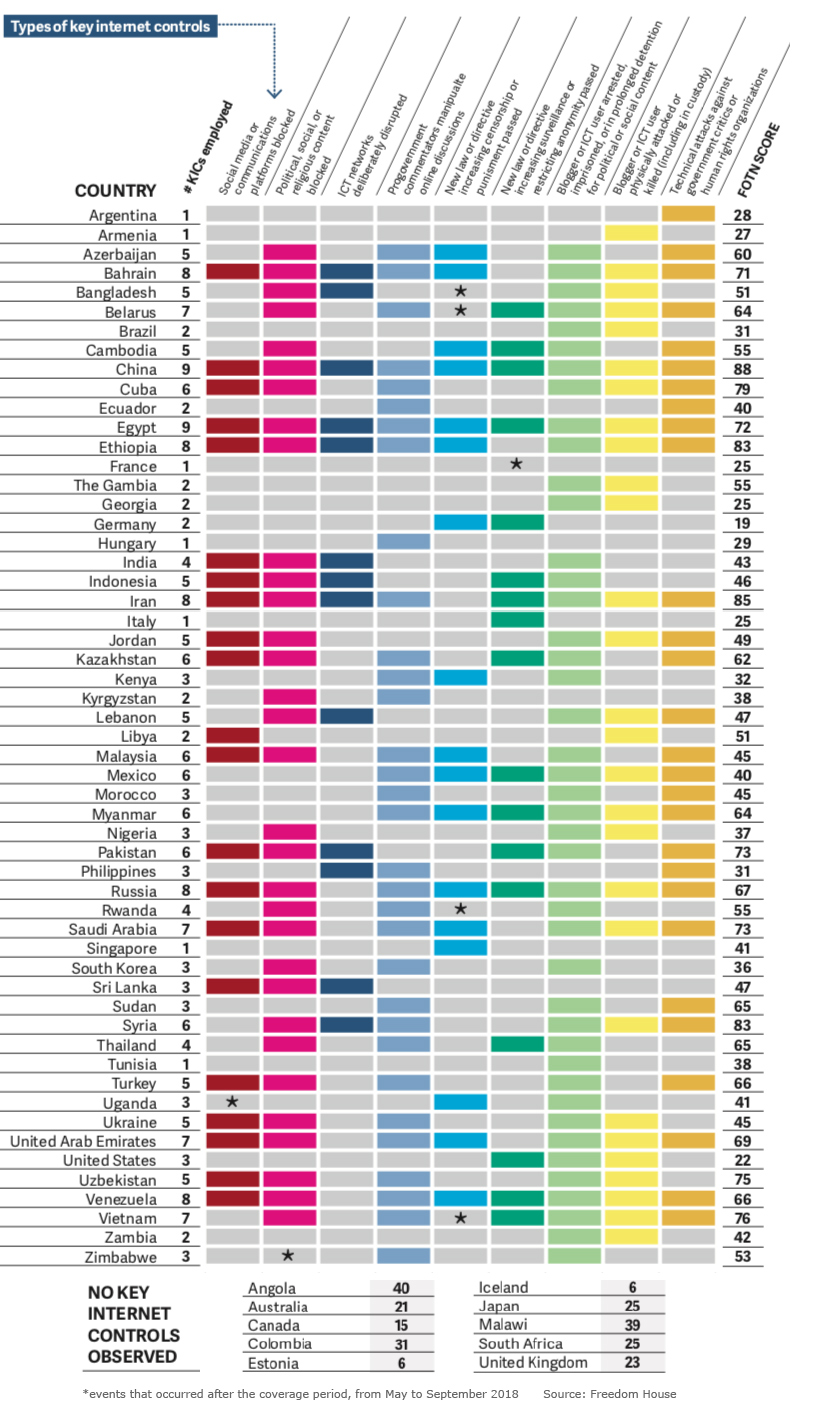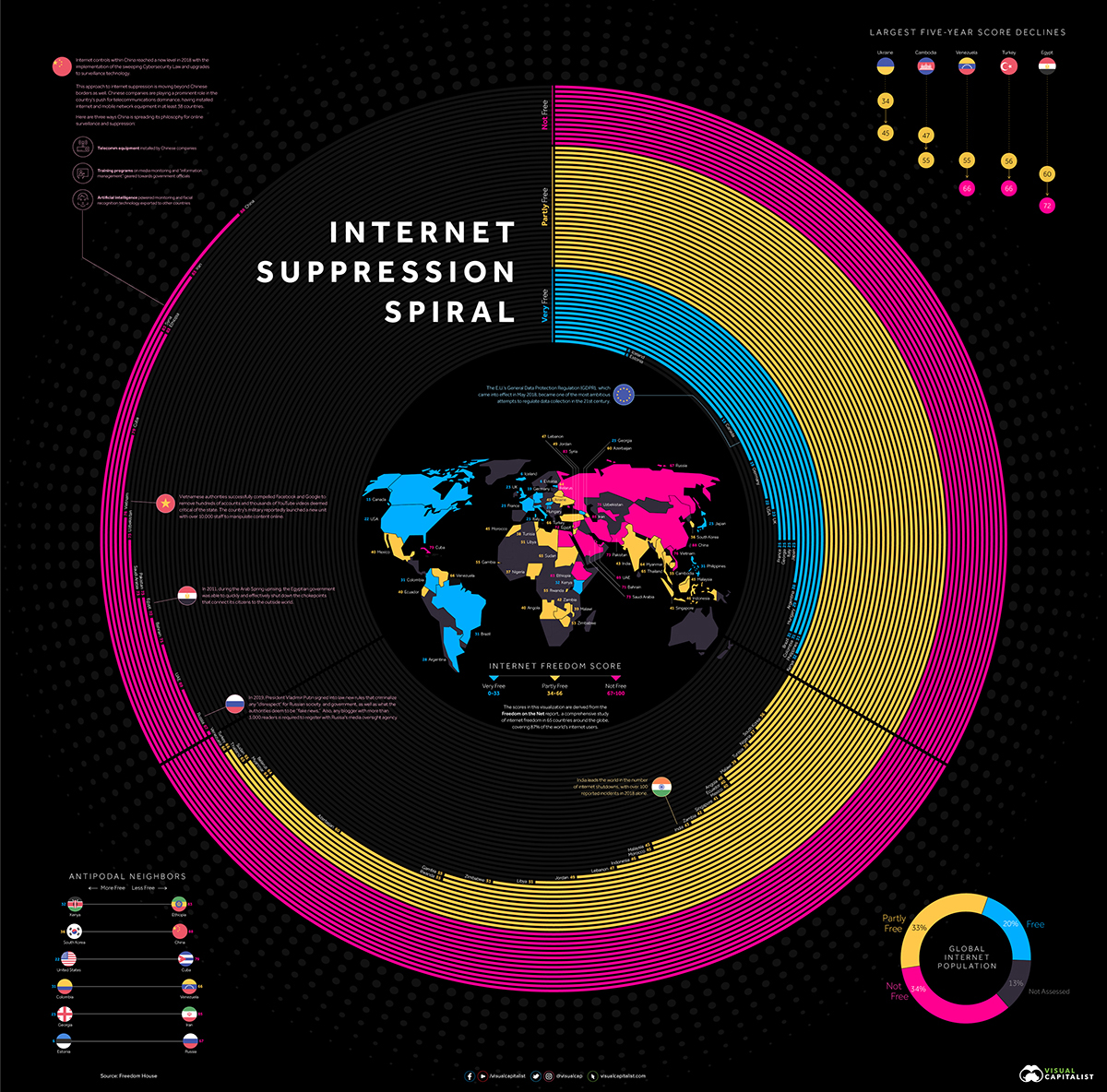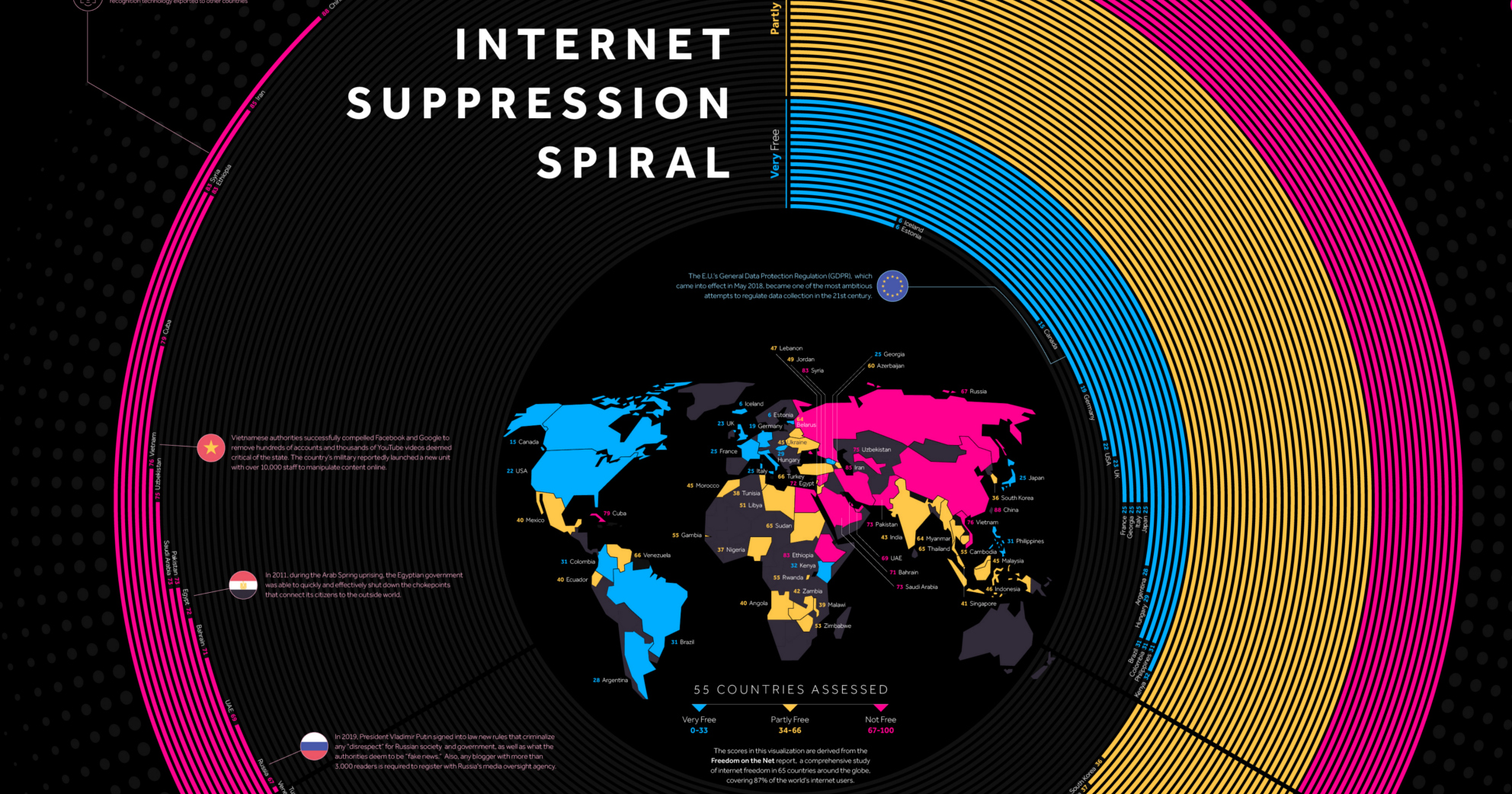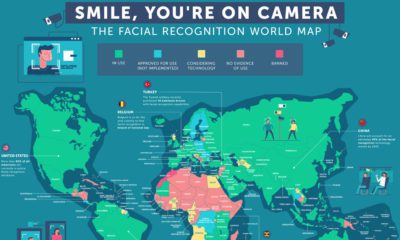Technology
Visualizing Internet Suppression Around the World
View the full-size version of the infographic
Visualizing Internet Suppression Around the World
View the full-size version of the infographic by clicking here
When people think of freedom, they often think it in the physical sense, such as the ability to act and behave in certain ways without fear of punishment, or freedom of movement within one’s country.
When a nation chooses to restrict freedom in the physical world, the results are often hard to ignore. Protests are met with tear gas and rubber bullets. Road checks pop up along transportation routes. Journalists are detained.
In the digital world, creeping control often appears in more subtle ways. Personal data is accessed without us knowing, and swarms of suspiciously like-minded accounts begin to overwhelm meaningful conversations on social media platforms.
The Freedom on the Net Report, by Freedom House, breaks internet suppression down into a number of elements, from content filtering to detention of online publishers. Here’s how a number of countries around the world stack up:

According to the report, internet freedom around the world has been falling steadily for eight consecutive years. Today’s graphic is an international look at the state of internet freedom.
First World Problems
At its best, the internet allows us to seek out information and make choices free from coercion or hidden manipulation. Even in countries with relatively open access to information this is becoming increasingly difficult.
In Western countries, internet suppression often rears its head in the form of misinformation and excessive data collection. The Cambridge Analytica scandal was a potent example of how the vast amounts of data collected by platforms and third parties can be used to manipulate public opinion.
The backlash to this data collection by tech companies also produced one of the most promising developments in the past year – the EU’s General Data Protection Regulation (GDPR). While the regulations are not applicable to government and military entities, it does create a pathway to increased transparency and accountability for companies collecting user data.
Control Creep
Around one-third of the people in the world live in countries that are considered “partly free”.
For most users, access to online information may not look too different from the internet experience in Iceland or Estonia, but there are creeping controls in specific areas.
In Turkey, Wikipedia was blocked and social media companies were compelled to censor political commentary. The country had one of the largest declines in internet freedom in recent years.
In Nigeria, data localization requirements have been enacted. This follows the lead of places like China and Vietnam, where servers must be located within the country for “the inspection, storage, and provision of information at the request of competent state management agencies.”
Access Denied
For many people around the world – particularly in Asia – accessing information online is a fundamentally different experience. Content published by an individual can be monitored and censored, and online activity that would be considered benign in Western countries can result in severe real-world consequences such as imprisonment or death.
As today’s data visualization vividly illustrates, China has by far the most restricted internet of the 65 countries covered in the report.
Network operators in the country are obligated to store all user data within the country (which can be accessed by governmental bodies), and are required to immediately stop the transmission of “banned content”. The country is also further cracking down the use of VPNs, which are used to circumvent China’s Great Firewall.
Of course, China is not alone in the desire to implement tight controls over online access. Many places, from Vietnam to Ethiopia, are eager to embrace the “China Model”. The country, which is aggressively ramping up its influence around globe, is more than happy expand its influence through exporting models of governance to new technologies, such as facial recognition.
Meanwhile, in Russia, the popular messaging app, Telegram, was blocked due to its refusal to allow the country’s security service access to encrypted data. This example highlights a growing dilemma faced by tech companies operating internationally – acquiesce to government demands, or lose access to huge markets.
A Tale of Two Internets
Today, there are two prodominant flavors of internet on the menu – the Silicon Valley offering dominated by major tech companies, and the top-down, state-controlled version being spread in earnest by Beijing. It would be a mistake to believe that the former is the clear choice for jurisdictions around the world.
In many countries in Africa, communications infrastructure is still being built out, so assistance from Chinese companies is accepted with open arms.
Our Chinese friends have managed to block such media in their country and replaced them with their homegrown sites that are safe, constructive, and popular.
– Edwin Ngonyani, Tanzania’s Deputy Minister of Works, Transport and Communication
Even though the internet is now three decades old, its form is still evolving. It remains to be seen whether the divergence between free and not free jurisdictions continues to grow.
Technology
All of the Grants Given by the U.S. CHIPS Act
Intel, TSMC, and more have received billions in subsidies from the U.S. CHIPS Act in 2024.

All of the Grants Given by the U.S. CHIPS Act
This was originally posted on our Voronoi app. Download the app for free on iOS or Android and discover incredible data-driven charts from a variety of trusted sources.
This visualization shows which companies are receiving grants from the U.S. CHIPS Act, as of April 25, 2024. The CHIPS Act is a federal statute signed into law by President Joe Biden that authorizes $280 billion in new funding to boost domestic research and manufacturing of semiconductors.
The grant amounts visualized in this graphic are intended to accelerate the production of semiconductor fabrication plants (fabs) across the United States.
Data and Company Highlights
The figures we used to create this graphic were collected from a variety of public news sources. The Semiconductor Industry Association (SIA) also maintains a tracker for CHIPS Act recipients, though at the time of writing it does not have the latest details for Micron.
| Company | Federal Grant Amount | Anticipated Investment From Company |
|---|---|---|
| 🇺🇸 Intel | $8,500,000,000 | $100,000,000,000 |
| 🇹🇼 TSMC | $6,600,000,000 | $65,000,000,000 |
| 🇰🇷 Samsung | $6,400,000,000 | $45,000,000,000 |
| 🇺🇸 Micron | $6,100,000,000 | $50,000,000,000 |
| 🇺🇸 GlobalFoundries | $1,500,000,000 | $12,000,000,000 |
| 🇺🇸 Microchip | $162,000,000 | N/A |
| 🇬🇧 BAE Systems | $35,000,000 | N/A |
BAE Systems was not included in the graphic due to size limitations
Intel’s Massive Plans
Intel is receiving the largest share of the pie, with $8.5 billion in grants (plus an additional $11 billion in government loans). This grant accounts for 22% of the CHIPS Act’s total subsidies for chip production.
From Intel’s side, the company is expected to invest $100 billion to construct new fabs in Arizona and Ohio, while modernizing and/or expanding existing fabs in Oregon and New Mexico. Intel could also claim another $25 billion in credits through the U.S. Treasury Department’s Investment Tax Credit.
TSMC Expands its U.S. Presence
TSMC, the world’s largest semiconductor foundry company, is receiving a hefty $6.6 billion to construct a new chip plant with three fabs in Arizona. The Taiwanese chipmaker is expected to invest $65 billion into the project.
The plant’s first fab will be up and running in the first half of 2025, leveraging 4 nm (nanometer) technology. According to TrendForce, the other fabs will produce chips on more advanced 3 nm and 2 nm processes.
The Latest Grant Goes to Micron
Micron, the only U.S.-based manufacturer of memory chips, is set to receive $6.1 billion in grants to support its plans of investing $50 billion through 2030. This investment will be used to construct new fabs in Idaho and New York.
-

 Education1 week ago
Education1 week agoHow Hard Is It to Get Into an Ivy League School?
-

 Technology2 weeks ago
Technology2 weeks agoRanked: Semiconductor Companies by Industry Revenue Share
-

 Markets2 weeks ago
Markets2 weeks agoRanked: The World’s Top Flight Routes, by Revenue
-

 Demographics2 weeks ago
Demographics2 weeks agoPopulation Projections: The World’s 6 Largest Countries in 2075
-

 Markets2 weeks ago
Markets2 weeks agoThe Top 10 States by Real GDP Growth in 2023
-

 Demographics2 weeks ago
Demographics2 weeks agoThe Smallest Gender Wage Gaps in OECD Countries
-

 Economy2 weeks ago
Economy2 weeks agoWhere U.S. Inflation Hit the Hardest in March 2024
-

 Environment2 weeks ago
Environment2 weeks agoTop Countries By Forest Growth Since 2001





